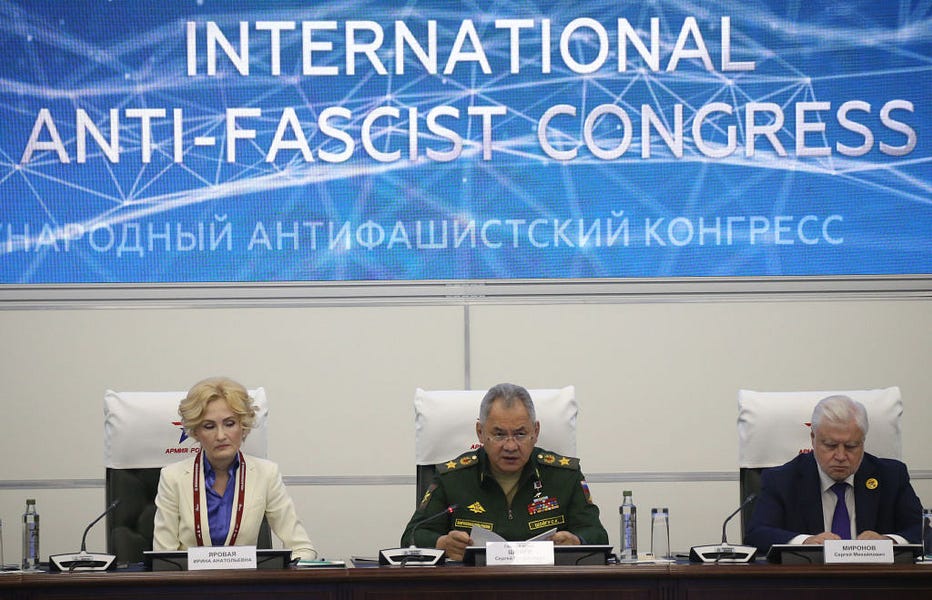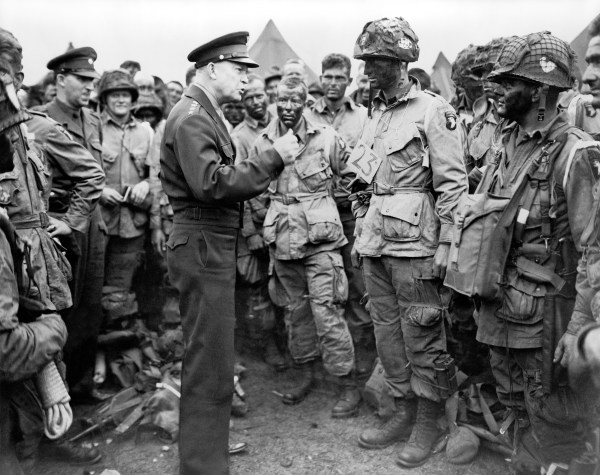The Kremlin is careful to project different images of Russia to the different foreign audiences it hopes to influence.
For the Western right, in particular the nationalists and populists who are more sympathetic to Vladimir Putin, it paints an image of a traditionalist state where Christianity has been reborn, where men can be men, and where the insanities of the woke European and American “establishment” are totally rejected. Meanwhile, the Western left is on the receiving end of messaging that shows Russia as a victim, a peaceful country reacting defensively after getting pushed around by the American empire.
Last week, catering to an internal audience, the Kremlin sought to put on a different face, at the “International Anti-Fascist Congress” held during an annual military exhibition. The messaging was closer to the version fed to the Western left on some points of substance, but in style it is a chip off the old Soviet bloc. Based on the available materials from the congress, it was a kind of official re-statement of the current ideology of the Kremlin, or at least of the Russian Defense Ministry, and the emphasis was on the Nazism of the West. The ideology that Russian Defense Minister Sergei Shoigu is broadcasting, or the remnants of an ideology, shows the continuity between the Soviets’ idea of their enemies and the enemies that Shoigu says he is fighting today.
Shoigu opened the Congress with a very Soviet speech, taking on the slippery task of defining fascism in the first minutes: “The staunch anti-fascist Georgi Dimitrov called fascism bestial chauvinism, medieval barbarism, and unbridled aggression against other peoples and countries.”
A word about Dimitrov. This “staunch anti-fascist” was the head of Communist International from 1935-1943, one of Stalin’s stable of activists who went on to be the first Communist dictator of Bulgaria. The quote Shoigu chose is just a small part of a longer disquisition from 1935, near the height of Stalinism, titled “The Class Character of Fascism.” Dimitrov’s quote there is part of his description of German fascism, the “most reactionary variety of fascism … the shock troops of the international counter-revolution … the instigator of a crusade against the Soviet Union, the great fatherland of the working people of the whole world.” According to Dimitrov, “Fascism is the power of finance capital itself.” He wrote that fascism could take different forms in different countries—sometimes in the form of social democracy and sometimes in the form of dictatorship—but that in every case fascism is a method of the “domination of the bourgeoisie.” In other words, fascist Germany in 1935 was similar to the United States of 1935 or the U.K. or France of 1935; it is just that in the supposedly “free” countries finance capital had better camouflage or had not yet come to the state of crisis where dictatorship was necessary.
In this text Dimitrov mocks the idea that this is some smoothly-running conspiracy, that some banker committee just decide to have a dictatorship one day, but he did believe that, at core, the levers of power under fascism were held by the same type of people who held power in the so-called democracies. Other ideologues and propagandists were not so circumspect, and directly accused Western bankers of hatching fascism as a plot against the revolution. In a 1940 book for the education of Communist cadres, Stalin described the rise of Hitler as part of a conscious plan by the “German bourgeoisie” to “suppress the working class.” A well-known Soviet cartoon from the 1930s depicted Hitler in the cradle, rocked by the French and British capitalists along with “Russian Magnates” and presided over by the guardian angel of “Wall Street” with wings of “military industry stocks”.
Shoigu probably never read Dimitrov’s work, but he was a Communist, and likely got plenty of indoctrination about the true nature of fascism and bourgeois democracy. If you pressed him, he would probably not display an ounce of cognitive dissonance in quoting a hard-core Stalinist to define fascism. In his speech at the International Anti-Fascist conference he makes a point of blaming Western capitalism for the rise of Hitler:
“The coming to power of National Socialism was due to their financing by international capital. It is quite obvious that the financial and economic cooperation between the Anglo-American and Nazi business circles was one of the main factors that led to the Second World War, which cost mankind unprecedented human casualties.”
In this view, Anglo-American capitalists are always scheming to destroy Moscow’s project. The project may no longer be socialist, but the Western-backed Nazi threat remains. Shoigu then breaks into the traditional lament of Russian imperialists who want to destroy Eastern Europe: His opponents are all Nazis. Memorials to Nazi collaborators are going up in Estonia and Latvia and Lithuania. He adds that the recent proposal to ban Russians from travel to Europe is also “another vivid manifestation of Nazi policy.” The main fight these days is, of course, the fight against Ukraine, and just as Western big capital created the rise of Hitler, Shoigu implies, so it is now generating a Ukrainian “Nazism.” Ukraine began oppressing its Russian minority, Shoigu narrates, and then NATO began to “develop Ukrainian territory.” This “created unacceptable threats to Russia’s security.”
As the defense minister, Shoigu knows that Russian forces were already involved in Ukraine in 2014. The “rebellion” there was not spontaneous resistance against Ukrainian “Nazism” but a Russian operation to crush the Maidan Revolution. Some deception in the cause of defeating the great deception of Western fascism is no great vice, he may reason.
The rest of the speech was given over to complaints about supposed Ukrainian atrocities, accusations about the Azov battalion (a favorite subject among Russian propagandists) and complaints about the “falsification of history,” etc. The overt nods to Soviet ideology in the first parts of the speech were not the only times this happened in this Soviet-style conference. A little later on the same day the vice-speaker of the Russian parliament, Irina Yarovaya, directly accused the United States of being an entity that finances Nazism and said that the transformation of Ukraine into a Nazi state was a project of Washington. Another Russian member of parliament, Sergey Mironov (a leader of the Kremlin-controlled “opposition” party “A Just Russia”), opined that we are witnessing “the prospect of a return to one of the darkest periods in human history” and that the war in Ukraine “is not a military conflict between two countries, two fraternal peoples. This is a confrontation between Russian civilization and world totalitarianism”—with the “totalitarian” side being the West.
Ideologies can be very sticky, and propaganda stickier still if it is ubiquitous enough for long enough. Russians were told for decades and decades that there was a conspiracy of Western bankers against them, that all democracies in the world were under the control of the CIA or some other Western intelligence agencies, that America was the country of hypocrisy and well-concealed oppression, and that any country trying to escape from Moscow’s orbit or disturb the Kremlin’s grip was part of some sinister Western project. The leaders of Russia still believe this; even if they are no longer socialists, they are still Soviet at heart.






Please note that we at The Dispatch hold ourselves, our work, and our commenters to a higher standard than other places on the internet. We welcome comments that foster genuine debate or discussion—including comments critical of us or our work—but responses that include ad hominem attacks on fellow Dispatch members or are intended to stoke fear and anger may be moderated.
With your membership, you only have the ability to comment on The Morning Dispatch articles. Consider upgrading to join the conversation everywhere.